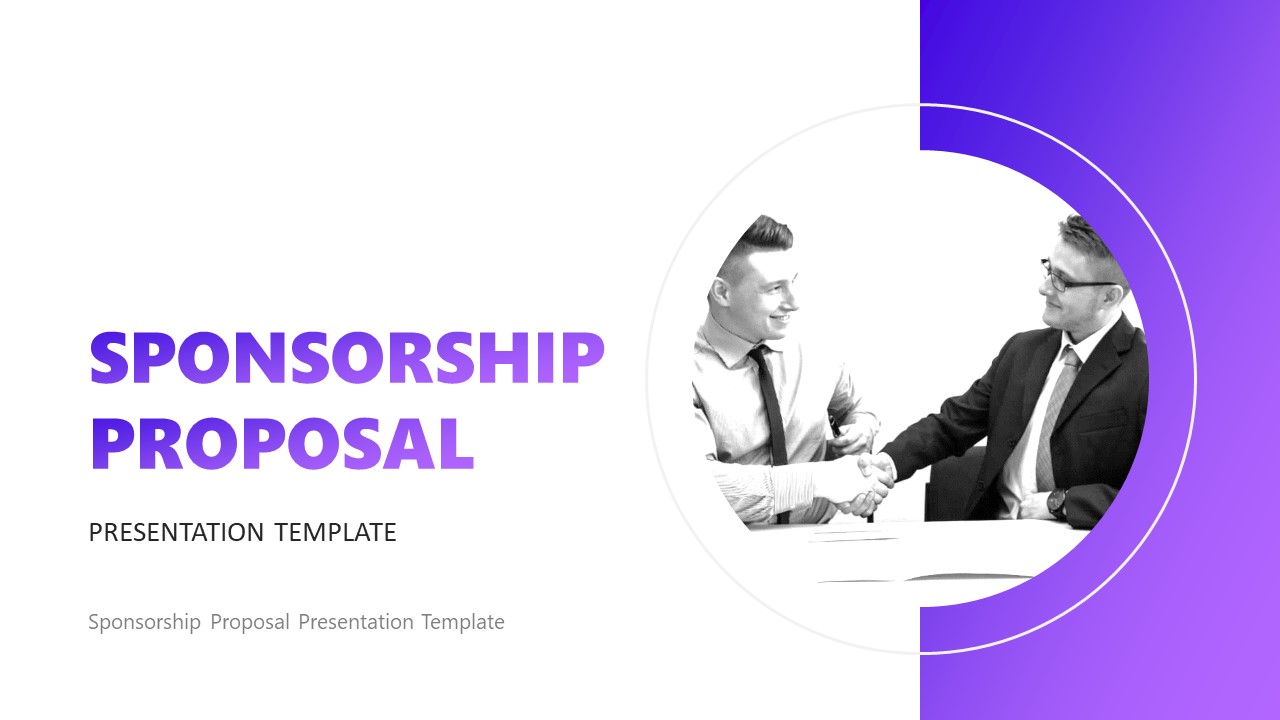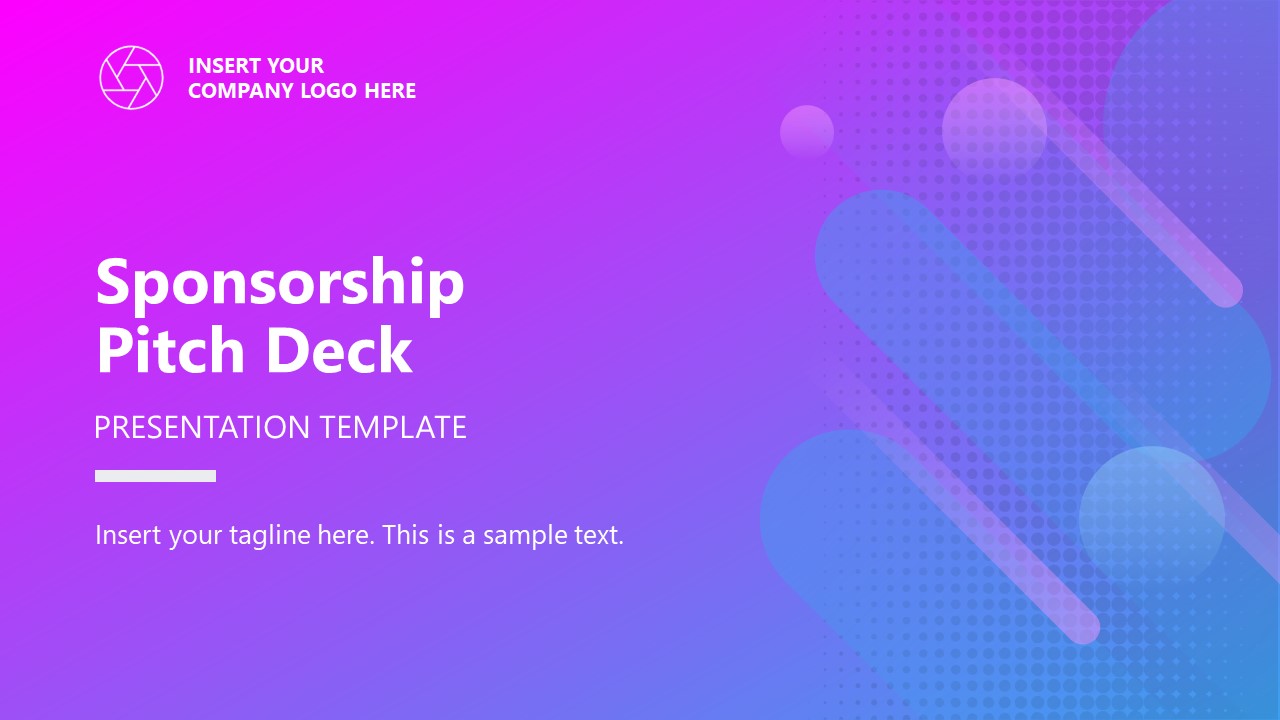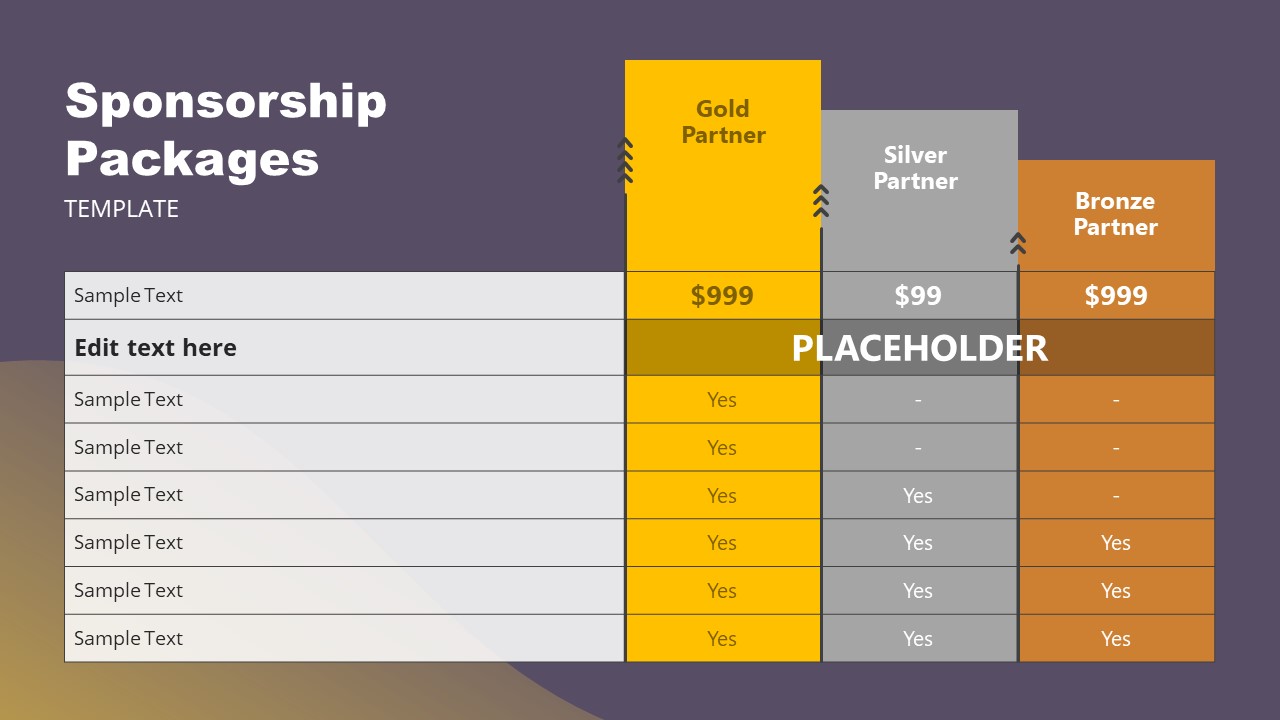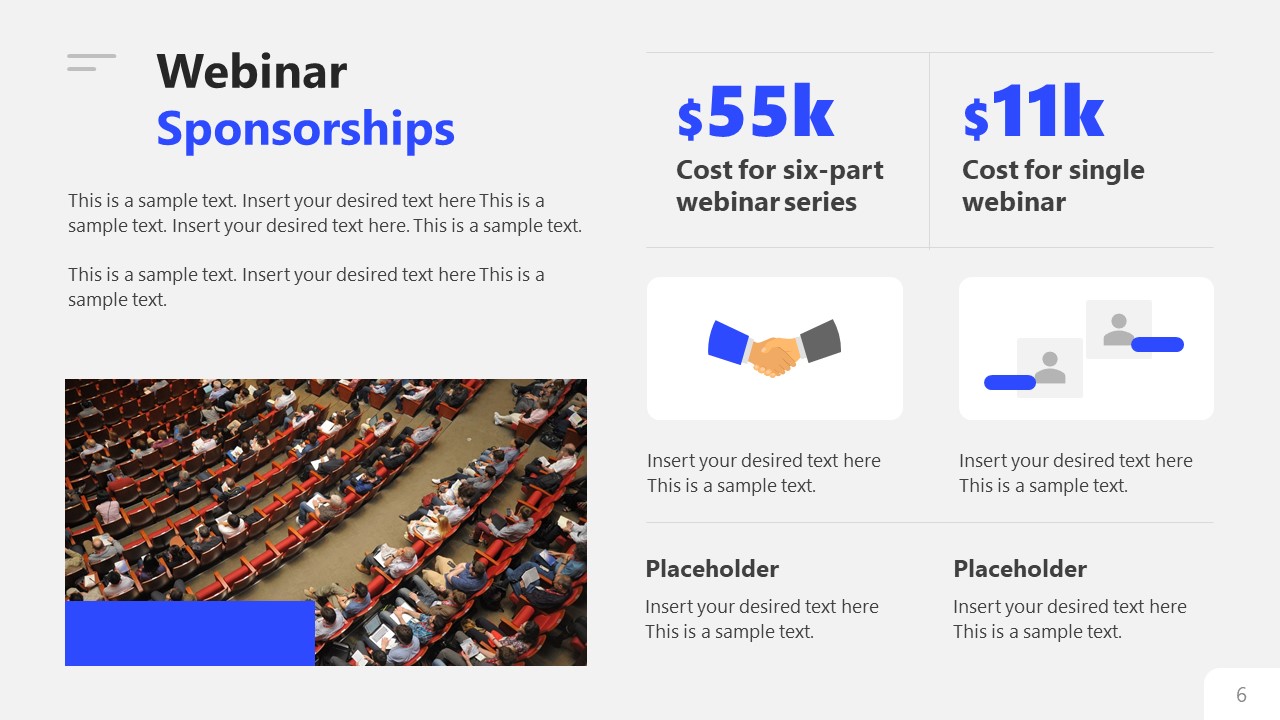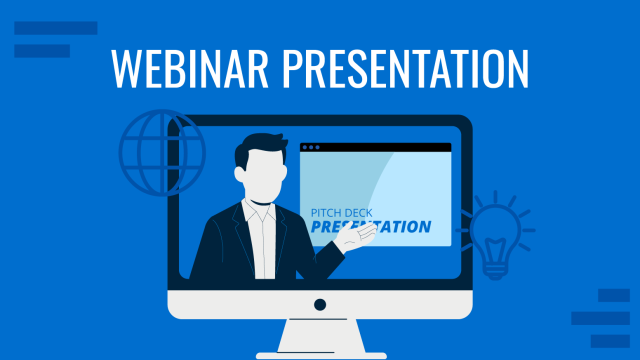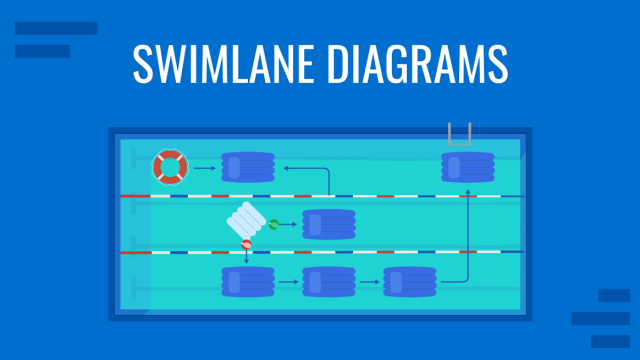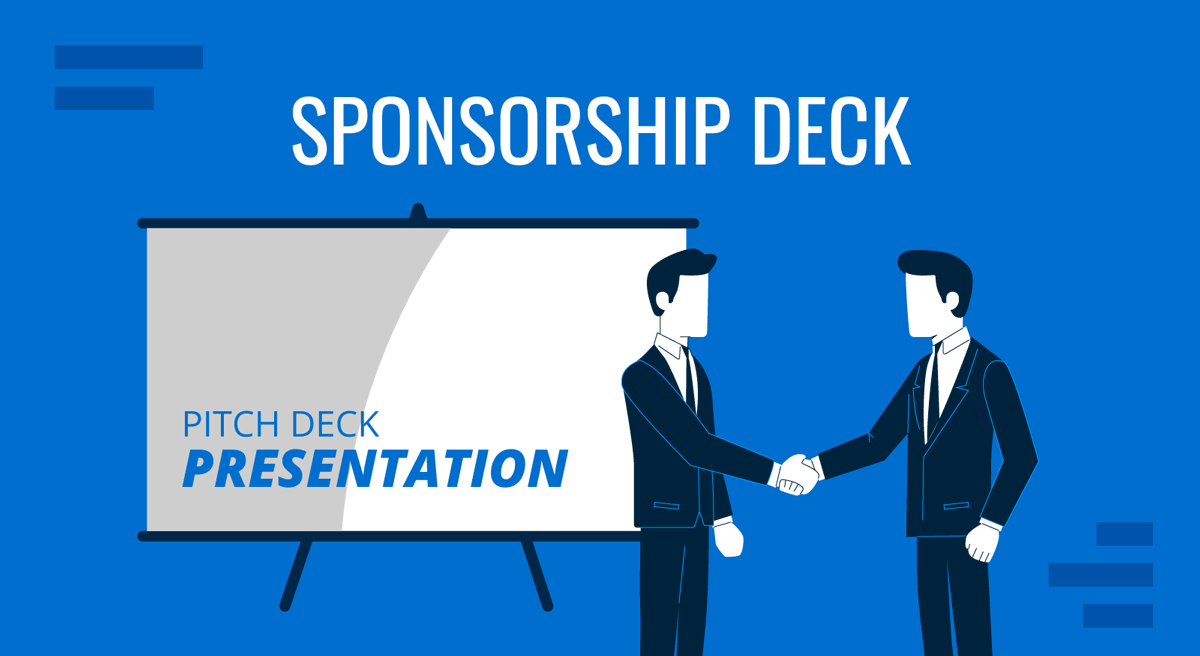
Events, crowdfunding initiatives, and social media influencers share an aspect in common: the need to connect with sponsors who can help turn ideas into reality. Raising funds to meet the budget needs is a daunting task that often forces organizers to reinvent themselves to attract prospective sponsors. For this reason, fostering high-quality visual communication skills is a must, and a tool stands out among all others on this behalf: the Sponsorship Deck.
Join us to discover the essential elements that build a winning sponsorship deck, how to tailor it for the interests of your target sponsors, how to demonstrate value and capitalize on benefits, and much more.
Table of Contents
- What is a Sponsorship Deck?
- Elements of a Sponsorship Deck
- Identifying Potential Sponsors
- Demonstrating Value to Sponsors
- How to Create a Sponsorship Deck
- Recommended Sponsorship Deck Templates
- FAQs
- Final Words
What is a Sponsorship Deck?
Also known as a Sponsorship Proposal or Sponsor Pitch Deck, it is a professional presentation crafted by event organizers, individuals, or organizations seeking sponsorship deals. Sponsorship decks help presenters provide a comprehensive overview of the sponsorship opportunity. This broadens the trust between the owner and potential sponsors as they can analyze the ROI regarding benefits, brand exposure, reinforcing their mission values, etc.
Elements of a Sponsorship Deck
The structure of a sponsor deck consists of a series of slides that should be arranged as follows.
Introduction
Presents the organization, event, or individual seeking sponsorship, offering a brief background and context. Introducing your sponsorship deck is your first opportunity to make a lasting impression. We highly recommend starting your presentation with an engaging opening that captures the essence of your event, program, or initiative.
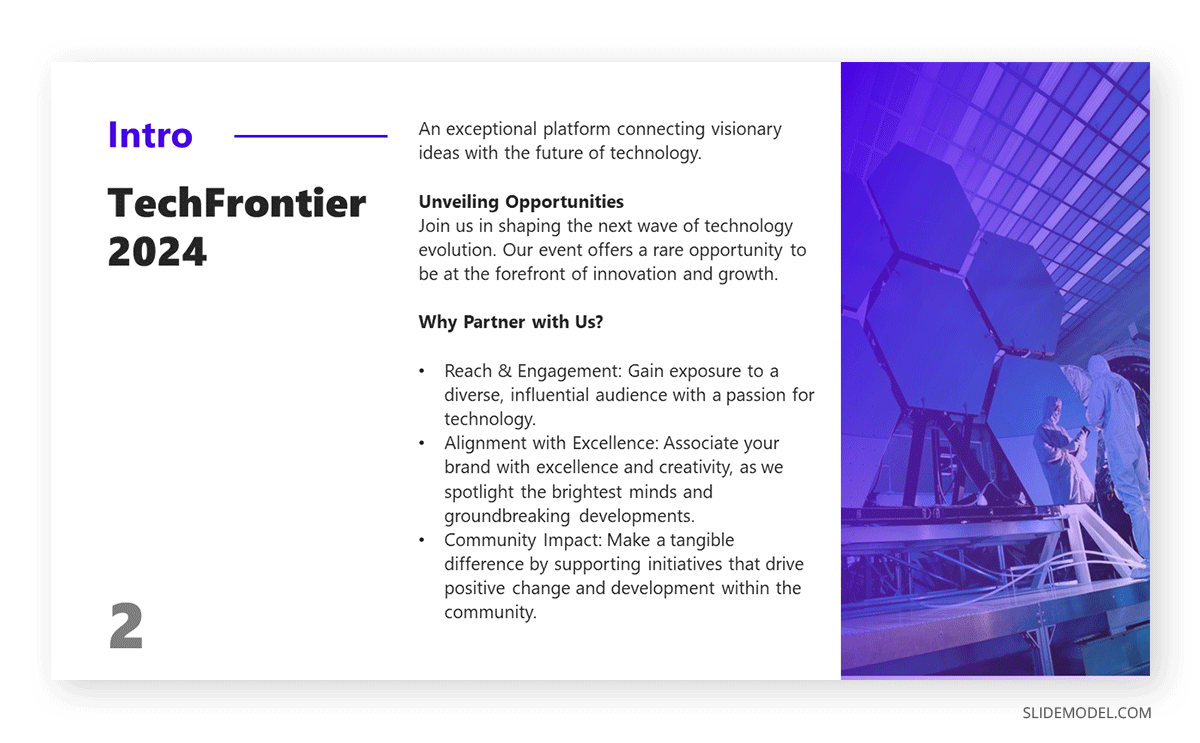
For those reaching out to connect with high-tier sponsors, it’s essential to immediately convey the uniqueness of your offer with a crystal-clear value proposition. Introduce your organization with a brief history, highlighting past successes and, if possible, awards achieved. Emphasize your strengths, expertise, and the position your organization holds in the industry or community. This section should establish credibility and set the tone for the rest of the presentation, driving authentic audience engagement from the sponsors.
Opportunity Overview
Here, the specific sponsorship opportunity is detailed. This could be an event, a program, a series of activities, or a long-term partnership. Describe the event or project in detail, focusing on what makes it stand out from competitors in the same industry and how it aligns with the sponsors’ interests.
Any pertinent information about the scale of the project/event, its significance, and social impact must be disclosed in this section with easy-to-spot metrics that back up your posture.
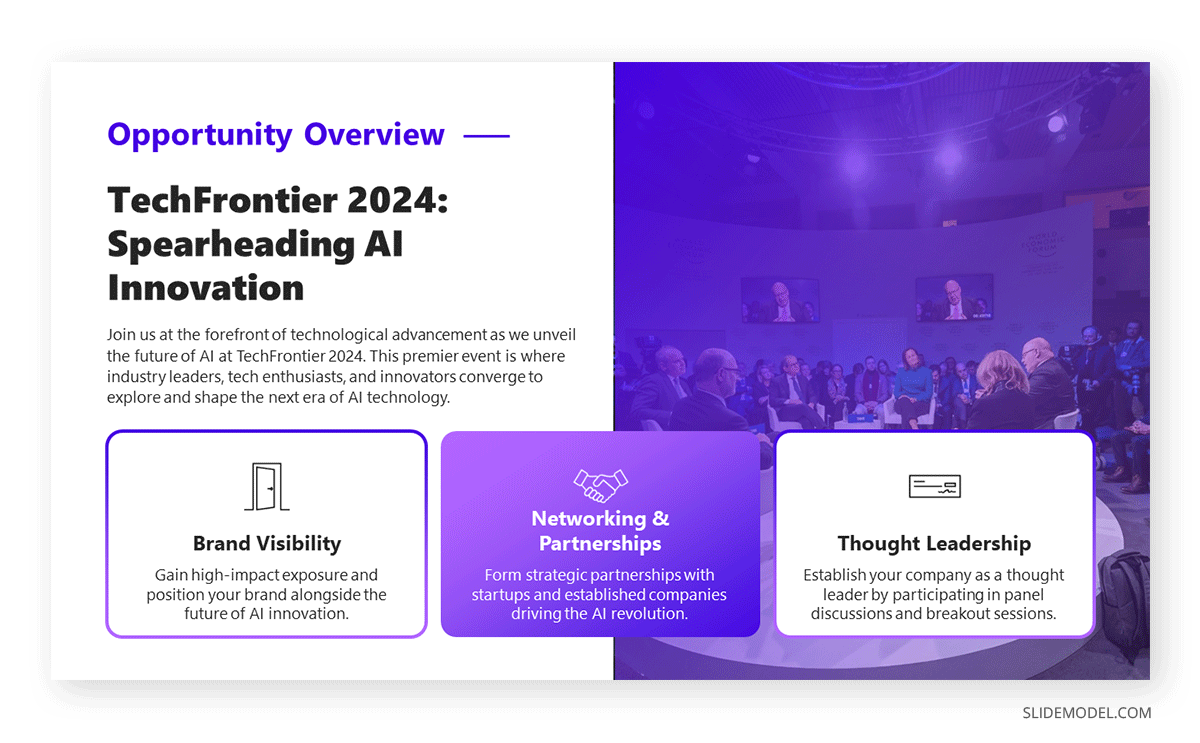
Target Audience
Businesspeople or companies won’t invest in your project unless they get trustworthy data on the demographics and psychographics of the target audience for this event. As with any marketing proposal, you should specify the ideal customer persona for which the event or product is catered. Then, go beyond and include information such as their interests, behaviors, and how this target audience can be converted into prospective customers for the sponsors’ companies.

In case you target sponsors who are philanthropists or venture capitalists, seek to align the value of the target audience in terms of their moral values. This concept can be explained as follows:
- A philanthropist seeks to make a difference in the world. For this type of sponsor, money is not an issue as long as the proposal aligns with the core values that represent them. Say your event is a product release of a new hair care product, but this product is vegan-based. It emphasizes the importance of why cruelty-free products make a difference, and some trendy models are willing to participate in your event because they believe in your value proposal. For the philanthropist seeking to bring attention to animal rights, this sponsorship deal captures their interest.
- On the other hand, a venture capitalist thinks first about profitability. The proposal has to be good to capitalize on the investment made in terms of more money or building their reputation. The sponsored party brings an attractive product offer, which turns out to be a diamond in the rough. The business plan is feasible, but the sponsored party intends to reach sponsors that can help position the product in the market. For a venture capitalist with experience in the same niche, this may turn into a gold mine after thoughtfully detailed information on financial projections is laid to the table.
Include data-driven insights like audience size, spending power, interests, and engagement metrics. Show how sponsoring your event or project provides direct access to a desirable customer base.
Sponsorship Benefits
This is arguably the most critical section of the pitch deck for sponsorship. It outlines what the sponsor will gain from the partnership. We can list brand exposure, media coverage, access to new markets, and networking opportunities. Tailor these benefits to align with the sponsors’ objectives.
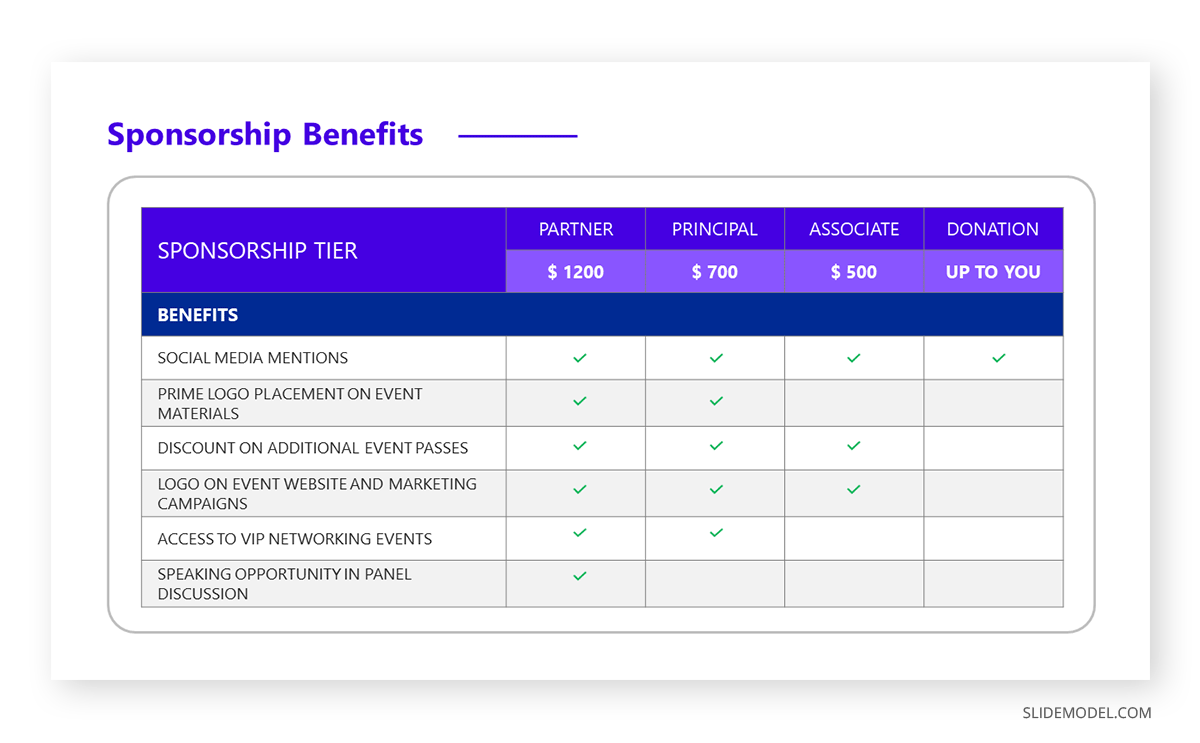
Large companies won’t dwell on simple facts or emotional value; they want engagements that can lead to tangible business results. Include case studies or examples of previous sponsorships and their outcomes to demonstrate potential ROI. If this is your first time pursuing a sponsorship deal, refer to testimonials on the value of your proposed offer or craft a detailed study comparing similar past experiences in your niche and why your company can offer ‘x times better results than this brand.’ Of course, this information should be backed up by data-driven insights.
Sponsorship Levels
The next element in a sponsorship pitch is a tiered system, offering different benefits based on the level of commitment/contribution from the sponsor. A good practice is to work with three tiers, scale them from the highest paid level (which features all benefits) to the lowest, and present the options included per level. Wealthy sponsors look for exclusivity and significant impact, so one method to differentiate between tiers is to offer unique benefits like:
- Exclusive access to specific segments of the event.
- Strategic placement of products in the event’s venue.
- A spot between the “exclusive” sponsors of the brand (commonly done in sports; F1 is a fine example of this with 2-3 main sponsors and several other brands represented to a lesser scale).
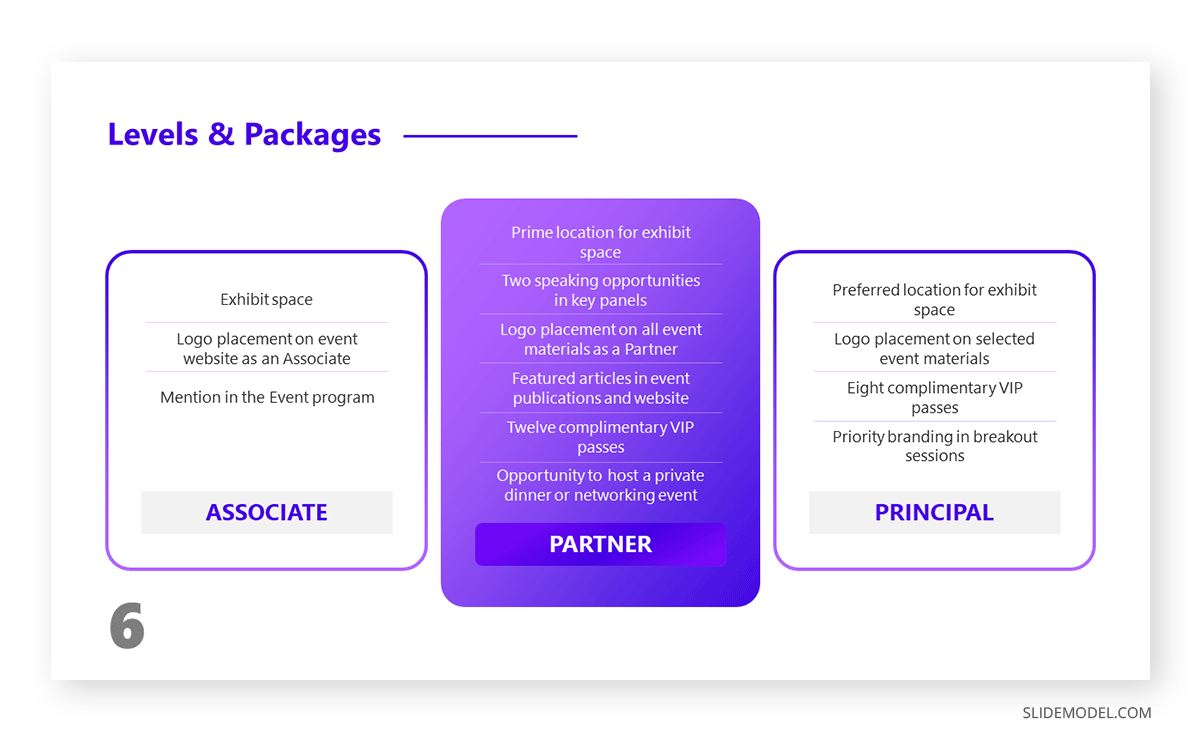
Provide flexibility in your packages, allowing sponsors to tailor benefits to their marketing and business goals.
Past Successes and Testimonials
Why would anyone invest in your project or ideas without further referencing your work ethic, success rate, or expertise in the nice? If applicable, this section showcases previous successful sponsorships or events, including testimonials from past sponsors or participants.
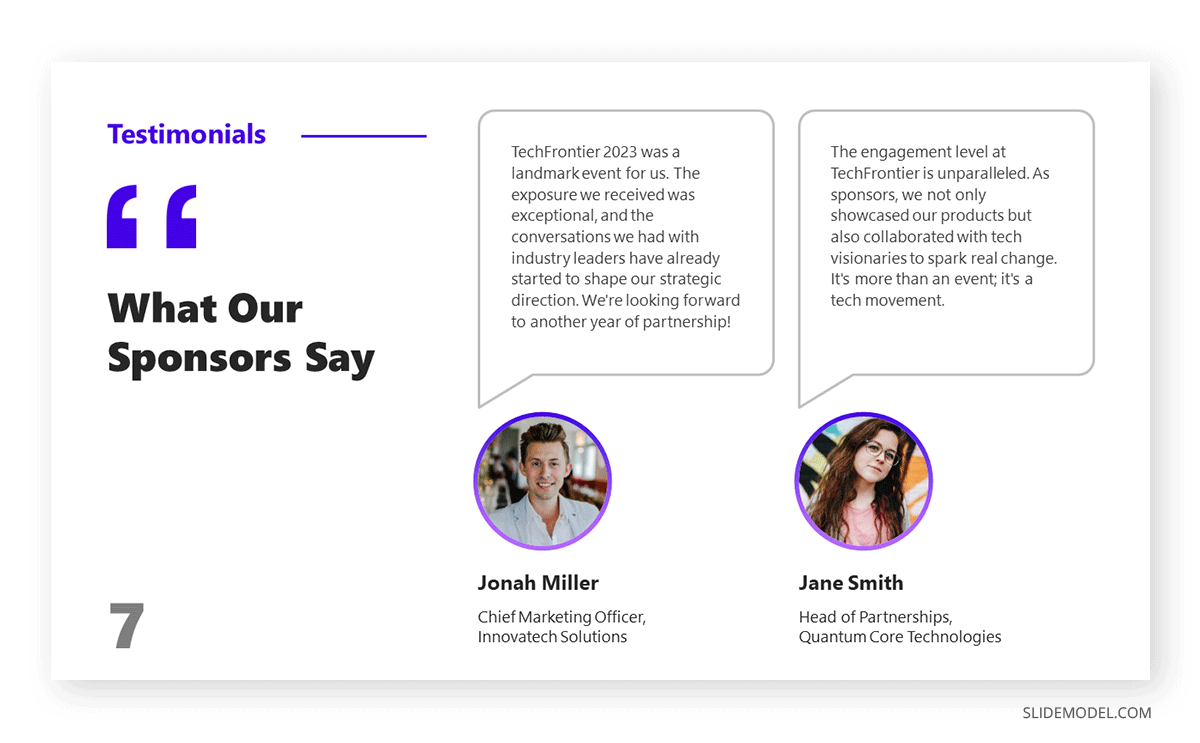
These testimonials can come in video interviews with past sponsors, dashboards representing KPIs reached in previous events – focusing only on ROI for the investors – testimonials about your work ethic or why it is important to adhere to your project, etc. If you have any awards linked to past events/projects, present them in this section as well, as they help to validate your proposal.
Call to Action
End your presentation with a compelling call to action. This should guide potential sponsors on the following steps to engage with your opportunity. Make it easy and inviting for sponsors to express interest or get in touch for more details.
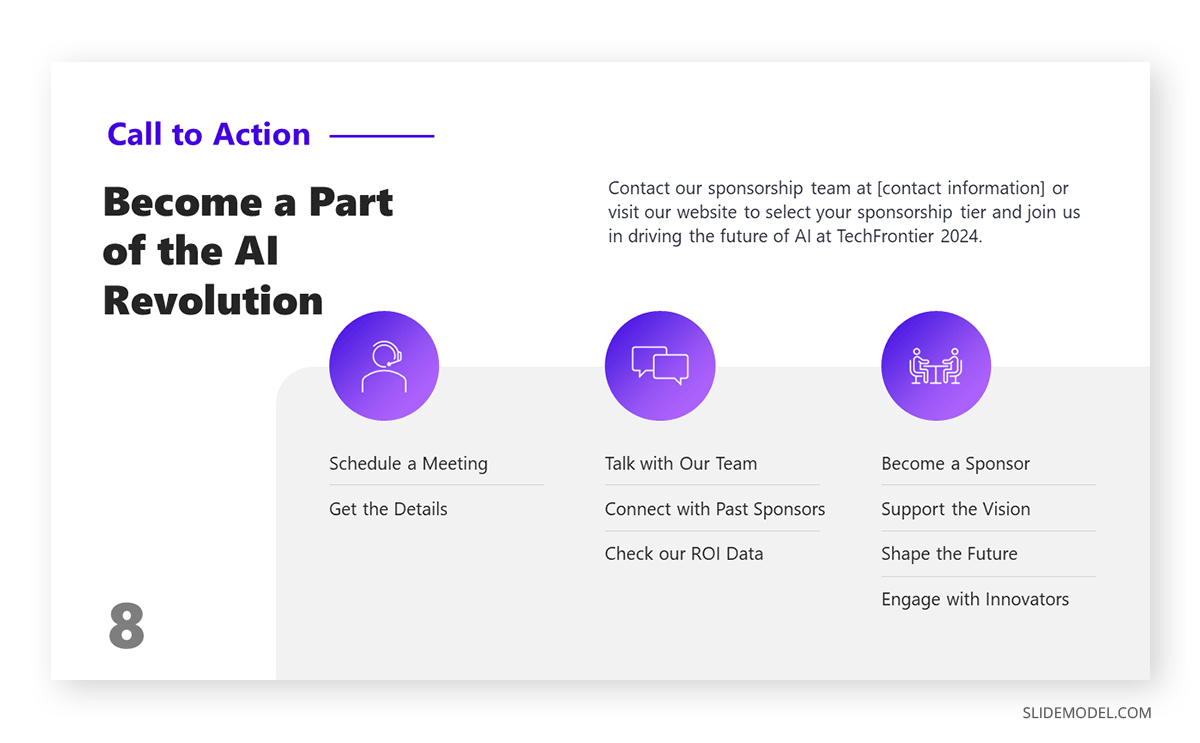
Regarding crowdfunding initiatives or sponsorship deals linked to product releases, you can wow your audience with a demo reel of how the product would work in real life. For events, you can be a little more creative with ideas like these ones:
- Schedule a Meeting: “Ready to Explore This Opportunity? Let’s Schedule a Meeting!”
- Include a calendar link or contact information to schedule a discussion easily.
- Request for Proposal Submission: “Submit Your Proposal Today and Become a Part of Our Success Story!”
- Offer a link or instructions for sponsors to submit their sponsorship proposals.
- Direct Contact Invitation: “Talk to Us! Contact [Name] at [Contact Information] for a Personalized Conversation.”
- Provide direct contact details of a key person for sponsors to contact.
- Download Additional Information: “Want More Details? Download Our Full Sponsorship Information Pack”
- Provide a link to download more comprehensive sponsorship details or additional resources.
- Interactive Webinar Invitation: “Join Our Exclusive Webinar to Learn More About Sponsorship Opportunities”
- Invite potential sponsors to an informative webinar where they can ask questions and learn more.
- Virtual Tour of the Event: “Experience Our Vision – Take a Virtual Tour of What We Have Planned”
- Offer an interactive virtual tour of the event or past events to showcase the potential experience.
- Special Offer for Early Decisions: “Act Now! Special Benefits for Early Commitments”
- Incentivize quick decisions by offering additional benefits for sponsors who sign up early.
- Feedback Request: “Tell Us What You Think! We Value Your Feedback and Ideas”
- Encourage sponsors to provide feedback on the sponsorship deck or propose their ideas.
- Exclusive Preview Invitation: “Get an Exclusive Preview! Join Us for a Sneak Peek of the Event Preparations”
- Invite potential sponsors to an exclusive behind-the-scenes look at event preparations.
- Personalized Proposal Offer: “Let’s Create Something Together – Contact Us for a Tailored Sponsorship Proposal”
- Offer to create customized sponsorship proposals based on the sponsor’s interests and needs.
Contact Information
This slide is optional; you can include the contact information in the CTA slide. In case you prefer to add an additional slide with your contact information, be sure to list:
- Phone
- Website (if applicable)
- Social Media profiles of your brand

Types of Sponsorship Decks
We can identify eight types of sponsorship decks, each with particular requirements to be created.
Event Sponsorship Decks
This is the most typical use case of a sponsorship deck, and it’s geared towards festivals, conferences, sports events, or charity fundraisers. These decks focus on cultural and ethical values to highlight the uniqueness of the opportunity, presenting precise data regarding audience demographics, location, theme, and scale of the event. The graphics for this sponsorship pitch deck depend mainly on the event’s theme.
Non-Profit Sponsorship Decks
These decks emphasize the organization’s mission and impact, the social or environmental cause it supports, and the benefits for sponsors in terms of corporate social responsibility and positive brand association. They often include success stories, testimonials, and detailed information on how the sponsorship funds will be utilized to further the non-profit’s goals.
Sports Sponsorship Decks
Sports teams constantly seek new partnerships; therefore, the sports sponsorship deck is a document in continuous revision tailored to potential new sponsors. This type of pitch sponsor deck focuses on the popularity of the sport, the team, or the athlete, along with fan demographics and engagement statistics. They highlight opportunities for brand exposure through team uniforms, event signage, media coverage, and merchandise.
Fine examples of the close relationship between sports teams and sponsors are seen in football games, where we can pinpoint each team’s sponsors on their uniforms, banners, advertisements, social media posts, team apparel, etc.
Entertainment and Media Sponsorship Decks
TV shows, music bands, influencers, YouTubers, and plenty of other parties in the entertainment industry use media sponsorship decks to promote the perks of being a sponsor in their activities.
These decks focus on aspects like viewer or listener demographics, content reach, and engagement metrics. They offer sponsors the opportunity to integrate their brand into content, access product placement opportunities, and leverage audiences’ emotional connection with the entertainment medium.
Real-life examples of the integration between media artists and sponsors are commonly seen in YouTubers, where they promote a brand that sponsors their videos at the introduction or mid-section of the video. This kind of content can be repurposed to reach new potential sponsors, as they can appreciate the final format of how their brand can reach unknown markets.
Corporate Partnership Decks
Corporate sponsorship decks require a deep understanding of both parties’ long-term objectives and often involve higher-level strategic discussions. They are not intended for one-time events.
Precise data on how both brands can align their strategic interests is typically presented alongside joint marketing initiatives, co-branded products, social responsibility goals, etc.
Technology and Innovation Sponsorship Decks
Tech events, startups, crowdfunding projects, and similars need the means to attract investors and provide data-driven analysis on why sponsoring those parties would benefit venture capitalists. They highlight technological advancements, potential market disruption, and early adopter demographics. These decks focus on the innovative edge and future growth potential, appealing to sponsors interested in being associated with cutting-edge developments.
Community and Local Business Sponsorship Decks
On a much smaller scale, this type of sponsorship deck is aimed to help local business owners or organizations raise the required funds for a project or event. Unlike fundraising slide decks, the benefits are highlighted to both parties regarding local impact, community engagement, and local marketing opportunities. These decks are often more personal and community-focused, emphasizing local relationships and direct community benefits.
Educational Sponsorship Decks
The final category for sponsorship decks lies in the educational niche, and it’s focused on opportunities to sponsor educational programs, scholarships, or academic events. These slide decks offer sponsors the chance to contribute to educational initiatives and gain recognition in the academic community.
Balancing Text and Visuals
Managing a perfect balance between graphic elements and written information can be challenging. The first step to ensure a high-quality sponsorship proposal deck is to outline its structure. We listed some must-know information on this behalf in our article on presentation structure.
Work with text as if it were another visual element: it must be legible from a short distance, clear to understand, and straight to the point. Short sentences and bullet points can help detox slides from massive text walls. By implementing this approach, sponsors can quickly grasp the required information to decide and not feel overwhelmed by a lengthy presentation.
Infographics can take your presentation deck to the next level as they are a powerful visual communication channel to express complex ideas. For instance, we can summarize the journey that led to creating a product in one infographic and narrate that journey thanks to storytelling techniques.
Consistency in design helps in keeping the sponsorship deck professional and cohesive. Use a consistent color scheme, font styles, and layout throughout the deck. This consistency should also reflect your brand’s identity, ensuring the deck aligns with your organization’s look and feel. In terms of the mix between text and graphics, you should remain between 60% graphics and 40% text. Another interesting approach is to apply the 10/20/30 rule for presentations.
Aim to tailor the graphics aesthetic to your potential investors’ interests and the opportunity’s niche as a final recommendation. For example, a food chain seeking sponsors may use bright, hand-made illustrations to accompany their slides, whereas a tech brand would opt for sleek graphics that inspire futurism.
Identifying Potential Sponsors
Working with the right set of sponsors influences the viability of projects from a financial point of view and the creditability and social value they can reach. Before creating a sponsorship deck, individuals or teams must focus on the potential sponsors for their project, how to attract them, and how to offer value in exchange for their support.
Clearly understand what you offer. What are the key attributes of your event, project, or organization? Who is your audience? What unique opportunities can you provide to a sponsor? This self-assessment will guide you in identifying sponsors whose goals align with your offerings.
The second stage of this process is to create your ideal sponsor persona. Consider factors like industry, company size, market presence, corporate culture, and past sponsorship history. Look at companies that have sponsored similar events or projects. Investigate businesses actively involved in community engagement or those looking to expand their market presence. Online databases, business directories, and industry reports can help to compile a list of potential sponsors.
Another approach is to analyze what competitors are doing. Brands with past experiences sponsoring businesses in your niche may be attracted to collaborate with your company. Still, your offer has to be unique, attractive, and easy to capitalize on. Networking events in your industry are a perfect chance to broaden your potential sponsor net.
The third stage is to evaluate what sponsors are looking for and see the points that match your proposal. Consider what they are looking for. Are they trying to reach a new audience? Increase brand awareness? Be associated with a particular cause or community? Understanding their goals will help you in tailoring your approach. Ensure that there is no conflict of interest with potential sponsors. This includes conflicts with your organization’s values or existing sponsors or partners.
Demonstrating Value to Sponsors
A good presenter and business person knows how to convert opportunities into deals. Sponsorship deals are sealed if the proposal clearly articulates the benefits investors will get in exchange for their support, but not to a superficial level. Most investors seek deals whose contribution leads to an increased market exposure or alignment with their social mission. For this reason, learning how to demonstrate value to sponsors when using a sponsorship deck equals learning how to secure a business deal.
Start by deeply understanding what each sponsor is looking to achieve out of investing. Tailor the sponsorship deck for each potential sponsor and demonstrate you did your homework regarding data-driven facts, an attractive proposal, and genuine interest in their commercial standing. Provide detailed demographics, psychographics, and behavior patterns of your audience. Showing the overlap between your audience and the sponsor’s target market can effectively illustrate the direct value they will receive in reaching potential customers.
Be flexible and ready to customize your pre-made offer, as negotiations are to be expected regarding benefits and investment sum. It does help to consider a security threshold you don’t want to fall below so your project remains feasible. That can be easily considered 10-15% of the sum projected. It gives you a comfortable negotiating position and won’t leave you as a newbie in sponsorship deals.
How to Create a Sponsorship Deck
This section will present a case study for a sponsorship deck in the fashion industry, which we briefly mentioned above. This company, which we shall call ‘Urban Utopia,’ is undergoing significant financial restructuring after a merger.
To remain within budget for their upcoming collection release, they need to secure the collaboration of at least three sponsors to co-host the event. Their marketing director devised an idea: to reach a partnership between Urban Utopia and hair care brands for the event. Urban Utopia will occupy the catwalk, while the sponsors will own stands where the attendants can test the products. The same products will be used in the hairdressing of the models showcasing the Urban Utopia collection, and there will be a joint digital marketing campaign to promote the event.
Step 1: Introduction Slide
Urban Utopia will present, using an infographic roadmap, its history as a trendy brand for women and men in their mid-20s, expose the reasons behind the merger for total transparency, and speak about its mission, vision, and purpose. The presenters can articulate the introduction into three slides: one for the basic information, mission, vision, and purpose. The second is the roadmap and the company’s history. The third slide is a resumed org chart of the people involved in the decision-making process for the sponsorship deals.

Step 2: Opportunity Overview
Now, the details of the event are disclosed. Urban Utopia intends to hire a venue to accommodate 300 attendees, among them leading experts in the industry, the press, fellow fashion designers, influencers, etc. The event will be held in March to release the Spring-Summer collection, and the fashion show will be streamed live through a significant network channel (Hello!).
Therefore, they require an investment to cover the remaining 30% of the event costs, but in exchange, they are interested in a long-term partnership with hair care and skin care brands. Each sponsor will have a fully arranged stand, allowing them to exhibit their products, with a dedicated area for testing the product at the event’s venue. Media advertising for each brand will be done by displaying the logo brands at key strategic places for live media coverage. Urban Utopia’s marketing team will manage social media campaigns promoting the brands. Unlike other fashion shows, it will be the first experience that includes personal care brands.

Step 3: Target Audience
The demographics for this event show that 60% of the attendees are women between 30 and 55, specialized in the fashion industry, and with solid connections in the niche. The second largest group is men in the 45-70 age range, representing 18% of the attendees, primarily investors or fashion brand owners/designers. Social media influencers represent 7% of the total attendees of this event, with a baseline of 2.2m followers in their social media profiles and targeting the audience between 17 to 28 yo., with solid buying capacity and located mainly in Europe and the U.S. East coast.
Concerning the live media coverage, the expected audience is over 7.2m viewers worldwide from different demographics and financial situations.
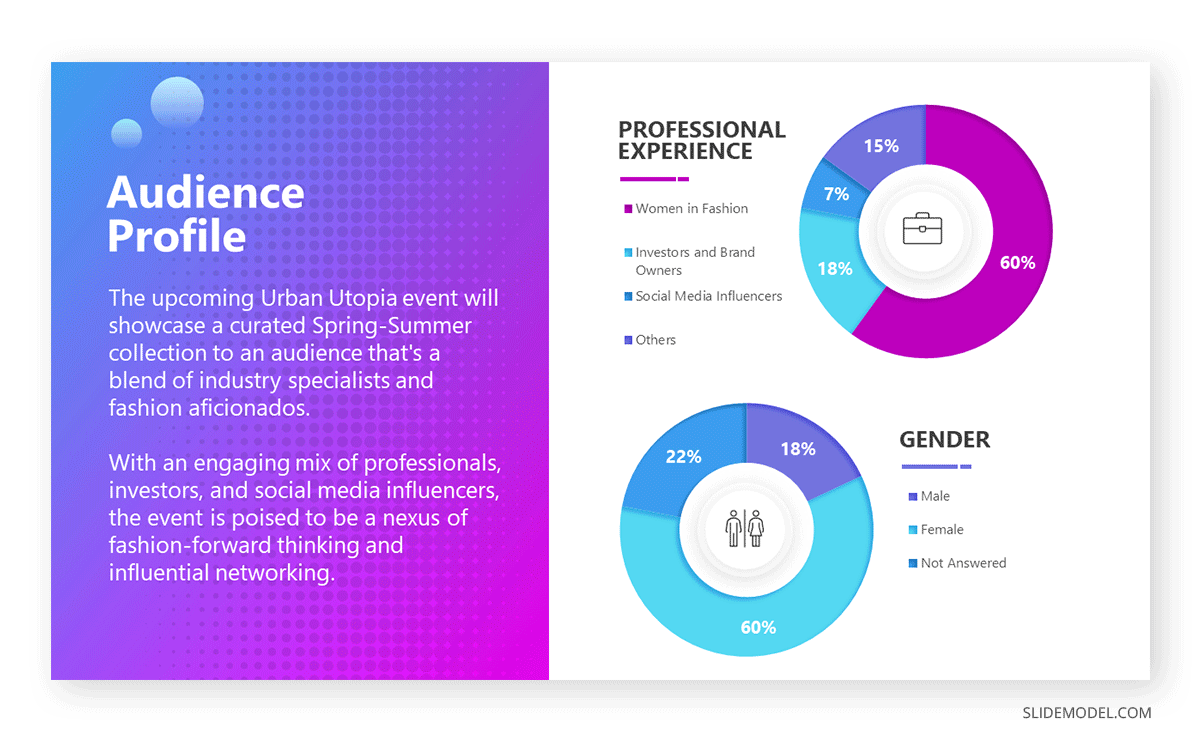
Step 4: Sponsorship Benefits
Clearly, the leading benefit of becoming a sponsor of Urban Utopia is the mass media coverage and networking opportunities. Brands relatively new to the market can benefit from the association with a well-established brand recently undergoing a refreshment after a merger.
The chance to promote their product in real-time allows fashion reporters to perform live tests of the products and promote them worldwide, creating a need to purchase across the mid-20s men’s and women Urban Utopia’s target audience.
Step 5: Sponsorship Levels
Urban Utopia offers three tiers of sponsorships. The Introductory Tier covers mentions on the red carpet wall of brands, a special thank you at the introductory speech, and a linked website on Urban Utopia’s site as a Recommended Brand.
The Partner Tier covers all the perks mentioned in the previous tier (brand flagged on their website as Partner Brand), a stand in the foyer area, and the brand’s logo on the model’s attending staff uniform.
The Enthusiast Tier covers everything the Partner Tier offers, changing the stand’s location to the catwalk’s surrounding area, with fully-equipped desks to perform live demos of the products. Additionally, the Enthusiast Tier grants access to the VIP area where the post-show party is held, an invitation to stand next to Urban Utopia’s CEO in the introductory speech, and major brand placement across all areas.
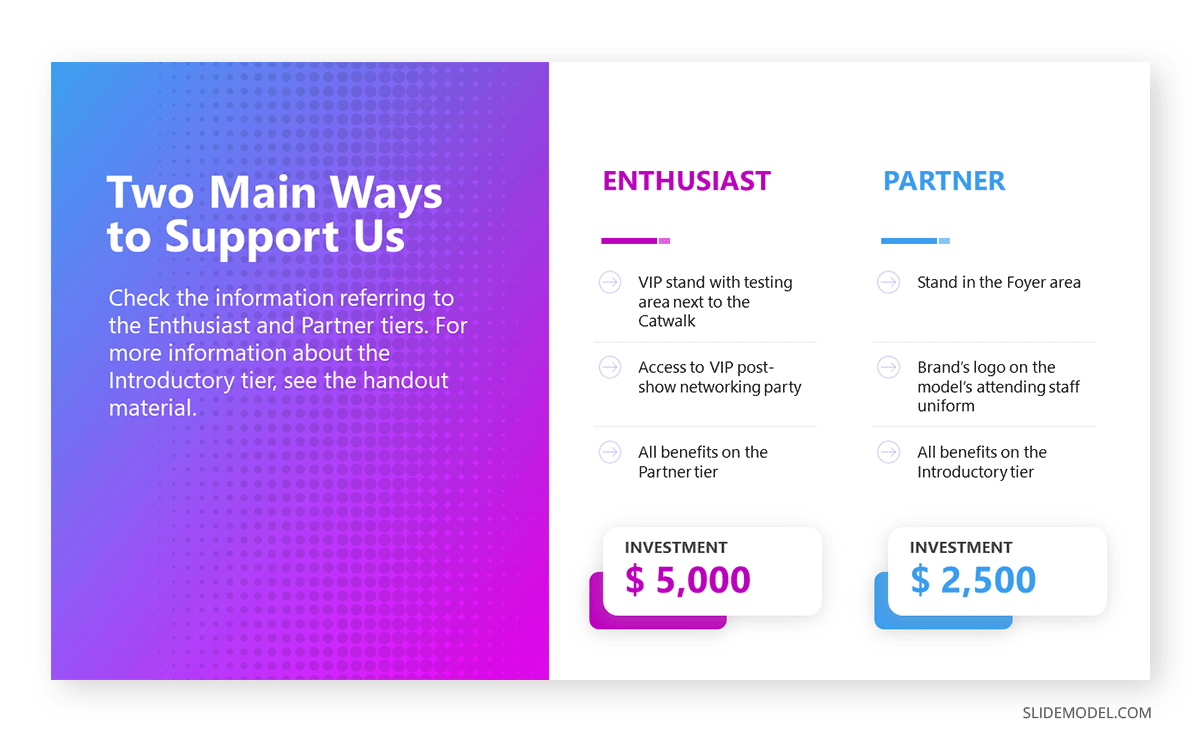
Step 6: Testimonials
A 3-minute reel showcases testimonials of past sponsor experiences with Urban Utopia. In particular, a popular event they did two years ago connecting emerging brands from Asia to be sponsors of their Summer Collection show in Osaka, Japan.
Step 7: CTA
The presentation concludes with powerful graphics inviting you to join Urban Utopia as a partner brand (the mid-tier being subconsciously advertised). All the information pertinent to reach the Marketing Department is shown in the slide.
Recommended Sponsorship Deck Templates
Check the following sponsorship deck templates by SlideModel to speed up your presentation design process. All these products are fully editable in terms of content, color theme, fonts, etc.
FAQs
What is the difference between a Sponsorship Deck and a Sponsorship Package?
Although they are used interchangeably, a sponsorship deck is a presentation intended to persuade the sponsors, whereas a sponsorship package covers all the legal aspects, terms, conditions, etc. The former is a legal-binding document acquired once the sponsorship deal is closed.
How often should I update my sponsorship deck?
Depending on your niche and activity, keeping the document updated once a month is recommended. If more deals arise, instantly update the presentation to meet the demands of new potential sponsors. Never attend a meeting without a tailored sponsorship deck, which shows a lack of preparation.
Should I include pricing in my sponsorship deck?
Yes, as it avoids confusion in any negotiating stage. Go with total transparency about the pricing and investment expected.
How can I measure the ROI for sponsors in my deck?
You can use a table or a dashboard to present the numbers linked to past sponsorship experiences handled by your brand. Additionally, projections made by your financial team can be presented as well.
What are some common mistakes to avoid in a sponsorship deck?
Avoid being too vague or repeating yourself when presenting the different sides of the opportunity. Of course, unprofessionally designed slides are a no, as well as a lack of customization for the potential sponsor or overpopulating the slides with content.
How do I make my sponsorship deck interactive?
Include clickable content linking to documents, videos, photos of previous events/projects, etc. Interactive presentations tend to leave a lasting impression.
How do I handle confidentiality in a sponsorship deck?
Start by avoiding sharing internal sensitive data. If required, an NDA (non-disclosure agreement) can be signed.
How do I follow up after sending a sponsorship deck presentation?
Use a personalized email or call your contact with the interested sponsor to see if they are still willing to take part in your project. Be ready to answer any question regarding legal or financial aspects.
Can I include a video in my digital sponsorship deck?
By all means, yes! Video presentations are ideal to convince people as they incite an emotional value.
Final Words
As we have seen, sponsorship decks are powerful tools to connect brands or individuals with interested investor parties. Building a high-quality pitch sponsor deck requires research, planning, and professionally designed assets, like PowerPoint templates. We hope this guide brings you the assets to create a stellar sponsorship deck presentation.
